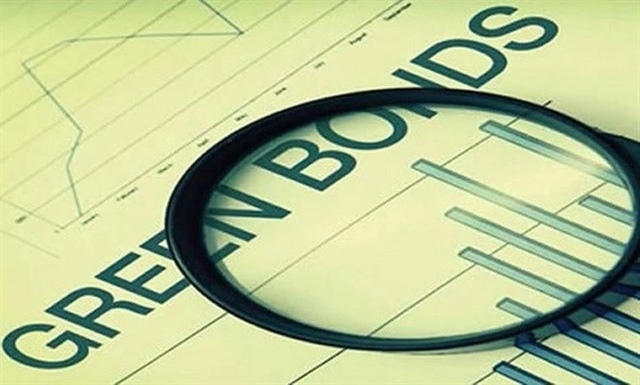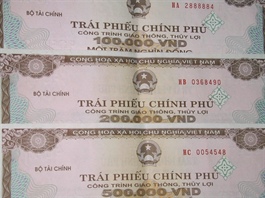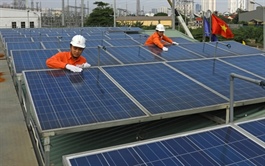Cost benefits meet legal, technical challenges in green bond market
Cost benefits meet legal, technical challenges in green bond market
Offering competitive borrowing costs, long-term capital and enhanced access to global environmental, social and governance (ESG) investors, green bonds are being increasingly viewed not just as a responsible financial instrument but as a strategic asset for growth.

From a modest base of VNĐ2.5 trillion in 2023, total green bond issuance surged to nearly VNĐ7 trillion by 2024. — AFP Photo |
The domestic green bond market is gaining traction as a viable finance tool for enterprises seeking to align capital raising with environmental and social goals.
Offering competitive borrowing costs, long-term capital and enhanced access to global environmental, social and governance (ESG) investors, green bonds are being increasingly viewed not just as a responsible financial instrument but as a strategic asset for growth.
However, regulatory fragmentation and technical capacity remain critical challenges holding the market back from broader expansion.
Recent market data from FiinRatings showed that coupon rates for several recent green bond issuances in Việt Nam have been below 6 per cent, already an attractive benchmark for corporate debt. Other costs include guarantee fees (1.5–2.5 per cent), upfront arrangement fees (1–2 per cent) and commitment fees (typically under 1 per cent).
Despite this, the estimated total cost for companies issuing green bonds is approximately 1-2 per cent lower than the interest rates for conventional bonds issued by similar companies within the same industry.
Green bonds provide tangible benefits to issuers, especially in terms of lowering capital costs. They also offer long-term funding sources that align with the investment cycles of renewable energy and infrastructure projects.
A case in point is AquaOne, a Vietnamese water infrastructure firm, which issued a 20-year green bond at a fixed 6 per cent interest rate. Despite including issuance and advisory expenses, the total financing cost remained near 8 per cent - a rate not achievable for a conventional corporate bond of similar tenor.
The company’s ability to attract long-term capital at this rate underscores the 'greenium' investors are willing to pay for assets that meet ESG criteria.
Beyond pricing advantages, green bonds also improve market reputation and unlock access to a growing class of global ESG-orientated investors.
The discipline required to issue green bonds, including transparent reporting, use-of-proceeds tracking and independent verification, helps strengthen internal governance and align companies with international sustainability standards.
Nevertheless, Việt Nam’s green bond market is still in its formative stage.
A core issue is the lack of a unified national green taxonomy – an official set of criteria to define which activities qualify as "green." Without it, issuers and underwriters face uncertainty in structuring transactions and verifying the environmental value of projects.
Bùi Quang Duy, CFA, deputy head of FI Investments, Climate Finance, responsAbility Investments AG, a Swiss asset management firm, told a recent conference on sustainable finance: "There is currently no sector-specific guidance or official list of green project categories, which creates confusion and inconsistency."
He emphasised that this lack of regulatory clarity undermines both investor confidence and the credibility of the market. Technical hurdles are also abound.
Many enterprises, particularly small and medium-sized ones, struggle with the required environmental and social assessments, ESG due diligence and post-issuance reporting obligations.
The limited number of independent verifiers and green bond certifiers further hampers efforts to comply with international standards such as those set by the Climate Bonds Initiative (CBI) or the International Capital Market Association (ICMA).
Regulators have acknowledged the challenges.
The State Securities Commission (SSC) is now working to align Việt Nam’s regulatory framework with ASEAN Green Bond Standards and global benchmarks. And market experts argue that deeper reforms are needed, including streamlined issuance procedures, tax incentives and stronger institutional coordination.
Vũ Chí Dũng, director of the International Cooperation Department at the SSC, said that transparency is not just a requirement. It’s the core condition for green finance to function properly.
He added that without a synchronised legal system, Việt Nam risks falling behind in the regional race for sustainable capital.
Despite these issues, the market is growing.
From a modest base of VNĐ2.5 trillion in 2023, total green bond issuance surged to nearly VNĐ7 trillion by 2024, according to Nguyễn Tùng Anh, head of Credit Risk Research and Sustainable Finance Services at FiinRatings.
Issuers now span various sectors, from banking and clean energy to water treatment and waste management, industries central to Việt Nam’s low-carbon development goals.
With Việt Nam committed to achieving net-zero emissions by 2050, green finance will play a pivotal role in resource mobilisation. Green bonds, in particular, are well positioned to become a cornerstone of this effort, provided that the regulatory infrastructure evolves in step with market demand.
- 09:31 18/06/2025
























